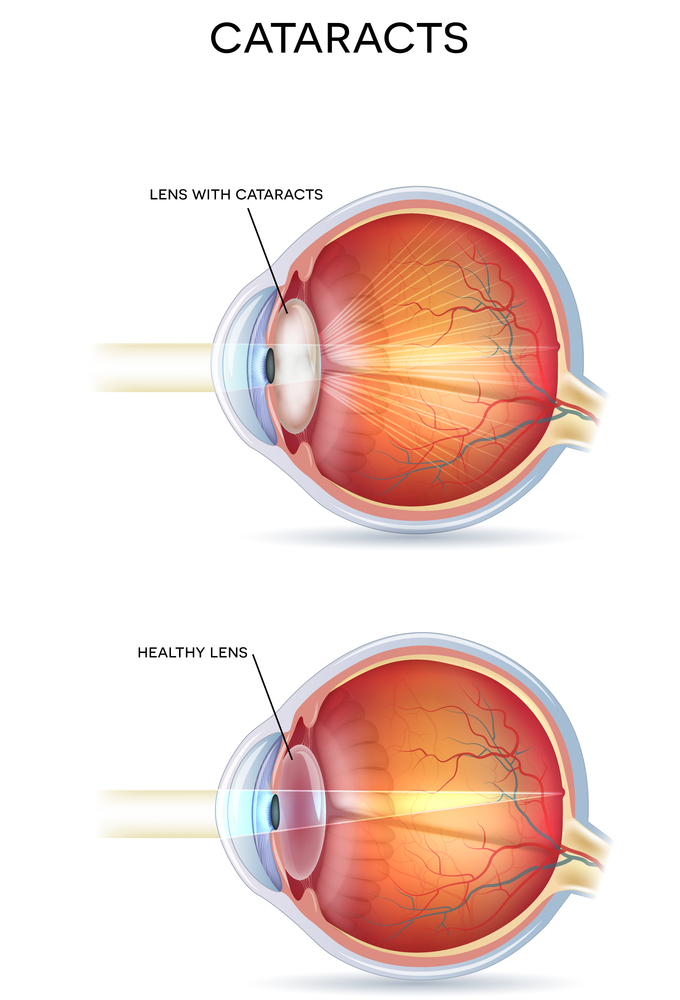Is your vision cloudy or blurry? Have you noticed that your eyesight is worsening? You may have cataracts.
Cataracts are the most common eye condition that can affect your vision as you age in the United States. The National Eye Institute estimates that by age 75, over half of Americans have developed cataracts that significantly impair their vision.
You can have cataracts in both eyes. However, learning more about what cataracts are, the symptoms and stages of cataracts, risk factors, and treatment options can help you feel more informed about them. Keep reading to learn if you can have cataracts in both eyes and what that means for your vision.
What are Cataracts?

Cataracts are a clouding of the naturally clear lens of the eye. The clouding caused by cataracts can make it seem like you are looking through a fogged-over or frost-covered window.
Cataracts occur when proteins and fibers within the lenses of your eyes break down and clump together. These clumps collect and build up on the surface of the lens, causing the lens to become cloudy.
Typically, cataracts advance slowly, and it may take many years for the effects of cataracts to impact your vision. While cataracts often start to develop around the age of 40, you may not have any noticeable symptoms at first.
While cataracts usually occur in both eyes, they do not always develop at the same rate. You may have cataracts that are worse in one eye, causing impaired vision in just that eye, while the vision in the other eye stays clear.
In rare cases, cataracts can develop in just one eye. Often, this is due to the eyes aging at different rates or injury to just one eye.
What are the Symptoms of Cataracts?
The symptoms you may experience can vary depending on how long you may have had cataracts or your individual eye health.
Cataracts may cause only minor changes to the structures of your eyes and may not even be noticeable when they are first developing. People often experience slightly blurred vision, difficulty focusing, and vision-related headaches.
As clumps of protein start to cover more of the lens, your pupil may appear cloudy, making it more challenging to see clearly. You may experience blurred vision in low light and impairment of close vision, in addition to the symptoms of early cataracts.
You may also experience persistent blurred vision, poor night vision, and a heightened sensitivity to bright lights and glare. This can impact your ability to drive, and you may have to have a friend or family member drive you.
The symptoms of cataracts may also affect mental health, as you may begin to avoid social interaction due to vision problems. As cataracts can affect your quality of life, receiving cataract surgery from your cataract surgeon at Batra Vision can improve more than just your sight. It can bring you the freedom to live independently without worrying about vision affecting your ability to enjoy life to the fullest.
Who Is Most at Risk for Developing Cataracts?

While aging presents the highest risk of developing cataracts, other factors can increase your chances of developing the condition. These factors include:
- Underlying health conditions, including diabetes and high blood pressure
- Smoking or a history of smoking
- Previous eye injuries, inflammation, or eye procedures
- Not maintaining a healthy weight
- Excessive consumption of alcohol
- Prolonged, unprotected exposure to sunlight or other sources of UV light
- A family history of cataracts, particularly early-onset cataracts
What is the Treatment for Cataracts?
The only effective, long-lasting treatment for cataracts is cataract surgery. While wearing glasses and contacts may help improve your vision in the early stages of cataract development, they can’t prevent cataract formation.
During cataract surgery, your cataract surgeon at Batra Vision will remove the natural lens of your eye and replace it with an intraocular lens (IOL). It is a quick, painless outpatient procedure.
Cataract surgery is a one-time treatment. Once lenses clouded by cataracts have been removed and replaced with an IOL, cataracts cannot return.
The standard IOL, which Medicare covers, is a monofocal lens. A monofocal lens can correct your vision at a single distance of your choosing. If you choose a monofocal lens, you will still need visual aids like reading glasses after your procedure.

If you want to make cataract surgery an opportunity to improve your vision at multiple distances, premium IOLs can reduce or even eliminate your dependence on visual aids like glasses and contacts. Premium IOLs are an out-of-pocket expense, meaning you may have to budget to pay for them, but they are usually well worth the investment.
If you have developed cataracts in only one eye, it is possible to treat just that eye. However, most eye doctors recommend treating both eyes as improved vision in one eye can lead to eye strain or other vision problems.
Your eyes will not be treated at the same time, as they need time to heal in between procedures. The procedures will often be spaced several weeks apart to allow for proper recovery time.
When you know more about cataracts, receiving a cataract diagnosis does not have to lead to an inevitable decline in the quality and clarity of your vision. While developing cataracts can lead to vision problems, cataract surgery can have you seeing clearly again in no time!
Want to know more about cataracts, cataract surgery, and the IOL options available for you? Schedule an appointment with Batra Vision in San Leandro, CA, today!

 Follow Us!
Follow Us!